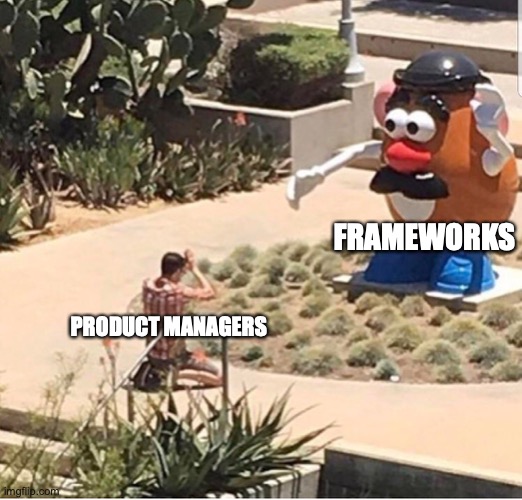You know it. Source: imgflip.com
Let’s jump right in — I guess this topic doesn’t require much of an introduction (hence the title image).
As the scene’s pet topic, we’re looking at our top recommendations for successful freelancing in product management:
1. Working backwards
Amazon approaches product management by “working backwards.” A former GM of Amazon, Ian McAllister, explained this approach in a Quora thread.

Amazon starts any new product by explaining precisely what they hope customers and the media will say when they get their hands on it.
Amazon doesn’t start by outlining a new product’s intended features or capabilities. At this point, they focus on the customer reaction they’re hoping to elicit.
If you’d like to learn more about this, I don’t want to steal Ian’s thunder by copying and pasting his content, so I highly encourage you to read his directly.
Useful because: It helps designing the outcome for a usually fixed project/period that freelancers have.
2. Kano Model
The Kano model is a theory for product development and customer satisfaction, developed in the 1980s by Professor Noriaki Kano, which classifies customer preferences into five categories, although most focus on 3 of them:
- Must-be: Features customers expect. Presence is taken for granted, absence causes strong dissatisfaction. Example: In a restaurant, customers expect a clean table & dishes.
- One-dimensional: Features that performance is measured by. Usually, the more/higher/stronger, the better (and vice versa). Example: In a restaurant, the less patrons wait for a table/service/food, the better they rate their experience.
- Attractive: Features customers are delighted by. Presence causes elation, absence causes indifference. Example: In a restaurant, complimentary dishes or drinks would delight customers, but they wouldn’t expect it.

- Indifferent: Features customers don’t care about either way. Usually a result of research. Example: In a restaurant, being overly polite to patrons might not sway them either way.
- Reverse: This is the “overengineered” part — mostly because not all customers are the same (one-size-doesn’t-fit-all). Example: In a restaurant, having a lot of choices on the menu and a very broad culinary range can dissatisfy customers because of the agony of choice — and even because of an implied negative perception that the establishment “tries to do everything at once, but nothing properly”.
Useful because: In addition to understanding the customer requirements, Kano adds the context of measurement — i.e. how much of something is needed; none, as little as possible, as much as possible, or ‘not too much’.
3. MoSCow Method
The MoSCoW method is a prioritization technique used in management, business analysis, project management, and software development to reach a common understanding with stakeholders on the importance they place on the delivery of each requirement — says Wikipedia.

If you haven’t heard of it before (which I highly doubt, hah!), MoSCoW stands for:
- Must have: Features, tasks or benefits unanimously deemed critical and mandatory for a working solution.
- Should have: Not fundamentally indispensable, but necessary to maintain e.g. a competitive edge, or perform in a market environment with established expectations.
- Could have: The “optional” stuff — would be good to have it, but can easily be omitted in a conversation around resource scarcity.
- Won’t have: The conscious decision to not pursue certain features.
The most power actually lies within the last — it is one of the few frameworks that incorporates bandwidth for a decision of omittance, thus establishing grounds for a more level conversation (because we all know such decisions need to be made, right?).
Useful because: A great canvas to discuss priorities & boundaries with stakeholders, as opposed to running into a scope creep trap.
Tip: Use Kano first to assess priority of desired outcomes, then use MoSCoW to prioritize the necessary action items!
4. Product Discovery
Product Discovery typically is an initial period during which you and your team ideate, research and validate to “build the right thing” — as opposed to “building the thing right” (which would then be Product Delivery).
Product Discovery can have many forms and structures, which is why I guess there’s no point in even attempting to go into detail here. I’d rather plug Tim Herbig as a prime resource here:
https://herbig.co/product-discovery/
Useful because: Particularly useful for consulting scenarios, a Product Discovery phase/workshop helps reshape & refocus strategy for product orgs that are too focused on execution.
5. MXP/Business Model Canvas
Ahh, the product management classic. You know ’em all — MVP, MLP, MMP, MSP, RAT (yes, Riskiest Assumption Test), and so forth.

The good thing about the concept of the MVP (for all the lost ones here, that’s minimum viable product) is that a lot of people know it, and can relate to it (despite not really understanding the what and the why). So it’s literally a good starting point
But before I move to discuss something that has been discussed to death in the community, I’d like to focus on the benefit for freelance product management:
Useful because: for two reasons:
- It establishes a fixed goal, and thus a fixed scope — which is helpful for fixed-term contracts.
- Whichever approach is used, they’re all focused on knowledge gain. Even if your KPI may be e.g. revenue on the surface, you can always approach it from an angle of hypothesizing being able to make $X revenue with Y feature set or resource allocation.
The tricky part is establishing to the client that you’re not building an MVP to “just barely pass and 80:20 this sh*t”, but to continually and iteratively generate learnings that produce and improve product offering as more of a windfall.
So, how about it?
Which ones of the above have you used already? Which ones did we fail to mention in your opinion? Are you readying yourself to call us out for referring to one of these methods “frameworks” when very technically, they aren’t a framework in your opinion? (In case of the latter, please don’t, because we don’t really care for that conversation, lol) Otherwise, We’d love to hear from you, please leave us a comment below!👇
Interested in more stories around freelancing in Product Management? We publish regularly to our Freelance Product Manager publication & would appreciate a follow! 👆
And as always,
Thanks so much for reading!
We acknowledge that with the 6 minutes, you could’ve literally done anything else, and we’re very honored that you decided to dedicate them to our piece! ❤️

